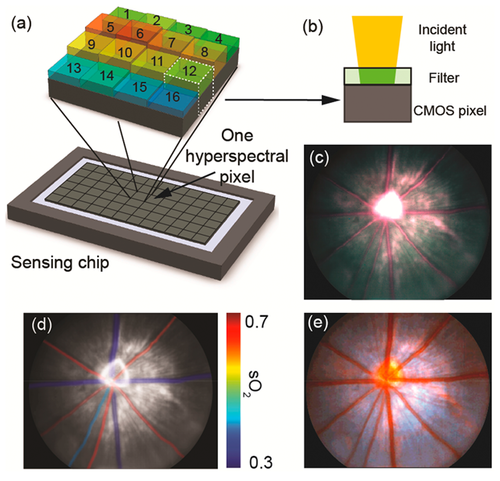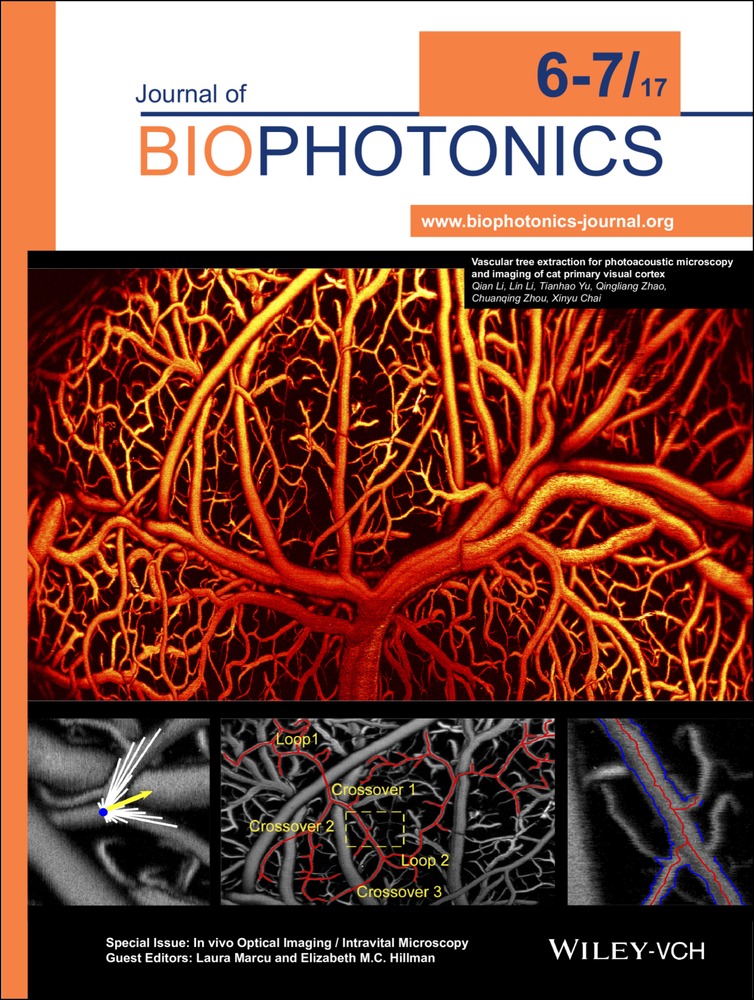Snapshot hyperspectral retinal imaging using compact spectral resolving detector array
Hao Li
Department of Biomedical Engineering, Northwestern University, Evanston, IL 60208 USA
Search for more papers by this authorWenzhong Liu
Department of Biomedical Engineering, Northwestern University, Evanston, IL 60208 USA
Search for more papers by this authorBiqin Dong
Department of Biomedical Engineering, Northwestern University, Evanston, IL 60208 USA
Search for more papers by this authorJoel V. Kaluzny
Department of Ophthalmology, Northwestern University, Chicago, IL 60611 USA
Search for more papers by this authorCorresponding Author
Amani A. Fawzi
Department of Ophthalmology, Northwestern University, Chicago, IL 60611 USA
Corresponding authors: e-mail: [email protected]; [email protected]
Search for more papers by this authorCorresponding Author
Hao F. Zhang
Department of Biomedical Engineering, Northwestern University, Evanston, IL 60208 USA
Department of Ophthalmology, Northwestern University, Chicago, IL 60611 USA
Corresponding authors: e-mail: [email protected]; [email protected]
Search for more papers by this authorHao Li
Department of Biomedical Engineering, Northwestern University, Evanston, IL 60208 USA
Search for more papers by this authorWenzhong Liu
Department of Biomedical Engineering, Northwestern University, Evanston, IL 60208 USA
Search for more papers by this authorBiqin Dong
Department of Biomedical Engineering, Northwestern University, Evanston, IL 60208 USA
Search for more papers by this authorJoel V. Kaluzny
Department of Ophthalmology, Northwestern University, Chicago, IL 60611 USA
Search for more papers by this authorCorresponding Author
Amani A. Fawzi
Department of Ophthalmology, Northwestern University, Chicago, IL 60611 USA
Corresponding authors: e-mail: [email protected]; [email protected]
Search for more papers by this authorCorresponding Author
Hao F. Zhang
Department of Biomedical Engineering, Northwestern University, Evanston, IL 60208 USA
Department of Ophthalmology, Northwestern University, Chicago, IL 60611 USA
Corresponding authors: e-mail: [email protected]; [email protected]
Search for more papers by this authorAbstract
Hyperspectral retinal imaging captures the light spectrum from each imaging pixel. It provides spectrally encoded retinal physiological and morphological information, which could potentially benefit diagnosis and therapeutic monitoring of retinal diseases. The key challenges in hyperspectral retinal imaging are how to achieve snapshot imaging to avoid motions between the images from multiple spectral bands, and how to design a compact snapshot imager suitable for clinical use. Here, we developed a compact, snapshot hyperspectral fundus camera for rodents using a novel spectral resolving detector array (SRDA), on which a thin-film Fabry–Perot cavity filter was monolithically fabricated on each imaging pixel. We achieved hyperspectral retinal imaging with 16 wavelength bands (460 to 630 nm) at 20 fps. We also demonstrated false-color vessel contrast enhancement and retinal oxygen saturation (sO2) measurement through spectral analysis. This work could potentially bring hyperspectral retinal imaging from bench to bedside.
Supporting Information
| Filename | Description |
|---|---|
| jbio201600053-sup-0001-video.mp4MPEG video, 1.1 MB | Video: SRDA captured temporal color and spectral changes of pure water, blue ink and red ink consecutively flowing through a tube |
Please note: The publisher is not responsible for the content or functionality of any supporting information supplied by the authors. Any queries (other than missing content) should be directed to the corresponding author for the article.
References
- 1G. Lu and B. Fei, J Biomed Opt 19, 010901 (2014).
- 2M. A. Calin, S. V. Parasca, D. Savastru, and D. Manea, Appl Spectrosc Rev 49, 435–447 (2013).
- 3D. G. Ferris, R. A. Lawhead, E. D. Dickman, N. Holtzapple, J. A. Miller, S. Grogan, S. Bambot, A. Agrawal, and M. L. Faupel, J Low Genit Tract Dis 5, 65–72 (2001).
- 4B. S. Sorg, B. J. Moeller, O. Donovan, Y. Cao, and M. W. Dewhirst, J Biomed Opt 10, 044004 (2005).
- 5J. A. Chin, E. C. Wang, and M. R. Kibbe, J Vasc Surg 54, 1679–1688 (2011).
- 6W. R. Johnson, D. W. Wilson, W. Fink, M. Humayun, and G. Bearman, J Biomed Opt 12, 014036 (2007).
- 7R. Gillies, J. E. Freeman, L. C. Cancio, D. Brand, M. Hopmeier, and J. R. Mansfield, Diabetes Technol Ther 5, 847–855 (2003).
- 8K. J. Zuzak, S. C. Naik, G. Alexandrakis, D. Hawkins, K. Behbehani, and E. H. Livingston, Anal Chem 79, 4709–4715 (2007).
- 9R. M. Schols, N. D. Bouvy, R. M. Dam, and L. P. S. Stassen, Surg Endosc 27, 1851–1859 (2012).
- 10D. J. Mordant, I. Al-Abboud, G. Muyo, A. Gorman, A. Sallam, P. Ritchie, A. R. Harvey, and A. I. McNaught, Eye 25, 309–320 (2011).
- 11A. H. Kashani, E. Kirkman, G. Martin, and M. S. Humayun, PLoS ONE 6, e24482 (2011).
- 12A. A. Fawzi, N. Lee, J. H. Acton, A. F. Laine, and R. T. Smith, J Biomed Opt 16, 106008 (2011).
- 13J. Schweizer, J. Hollmach, G. Steiner, L. Knels, H. W. Funk Richard, and E. Koch, Biomed Tech (Berl) 57, 293-296 (2012).
- 14V. Nourrit, J. Denniss, M. M. K. Muqit, I. Schiessl, C. Fenerty, P. E. Stanga, and D. B. Henson, J Fr Ophtalmol 33, 686–692 (2010).
- 15M. A. Sohrab, R. T. Smith, and A. A. Fawzi, Semin Ophthalmol 26, 156–166 (2011).
- 16A. Harris, R. B. Dinn, L. Kagemann, and E. Rechtman, Ophthalmic Surg Lasers Imaging 34, 152–164 (2003).
- 17L. Gao, R. T. Smith, and T. S. Tkaczyk, Biomed Opt Express 3, 48–54 (2012).
- 18N. Hagen and M. W. Kudenov, Opt Eng 52, 090901 (2013).
- 19N. Bedard, N. Hagen, L. Gao, and T. S. Tkaczyk, Opt Eng 51, 111711 (2012).
- 20B. Geelen, N. Tack and A. Lambrechts, New Multi- and Hyperspectral Cameras Cover Diverse Applications, http://www.photonics.com/Article.aspx?AID=53223, accessed: Feb. 21, 2016.
- 21 Hyperspectral imaging, http://www2.imec.be/be_en/research/image-sensors-and-vision-systems/hyperspectral-imaging.html, accessed: May 16, 2016.
- 22H. A. Macleod, Opt Acta 19, 1–28 (1972).
- 23 Image sensors and vision systems: hyperspectral imaging, http://www2.imec.be/be_en/research/image-sensors-and-vision-systems/hyperspectral-imaging.html, accessed: Feb., 2016.
- 24A. D. Broadbent, Color Res Appl 29, 267–272 (2004).
- 25E. Gordy and D. L. Drabkin, J Biol Chem 227, 285–299 (1957).
- 26N. M. Anderson and P. Sekelj, J Lab Clin Med 65, 153–166 (1965).
- 27N. Bosschaart, G. J. Edelman, M. C. G. Aalders, T. G. van Leeuwen, and D. J. Faber, Lasers Med Sci 29, 453–479 (2014).
- 28W. Song, Q. Wei, W. Liu, T. Liu, J. Yi, N. Sheibani, A. A. Fawzi, R. A. Linsenmeier, S. Jiao, and H. F. Zhang, Sci Rep 4, 6525 (2014).
- 29J. Yi, Q. Wei, W. Liu, V. Backman, and H. F. Zhang, Opt Lett 38, 1796–1798 (2013).
- 30N. Bosschaart, G. Edelman, M. G. Aalders, T. van Leeuwen, and D. Faber, Lasers Med Sci 29, 453–479 (2014).
- 31H. Li, W. Liu, and H. F. Zhang, J Biomed Opt 20, 106010 (2015).
- 32T. Liu, H. Li, W. Song, S. Jiao, and H. F. Zhang, Curr Eye Res 38, 1229–1234 (2013).
- 33S. P. Hibbs, A. Smith, L. P. Chow, and S. M. Downes, Eye 25, 918–921 (2011).
- 34F. LaRocca, D. Nankivil, S. Farsiu, and J. A. Izatt, Biomed Opt Express 5, 3204–3216 (2014).
- 35M. C. Butler and J. M. Sullivan, Invest Ophthalmol Vis Sci 56, 7159–7168 (2015).
- 36A. Bjorgan, M. Denstedt, M. Milanič, L. A. Paluchowski, and L. L. Randeberg, Proc SPIE 9318, 93180G (2015).
- 37D. F. Wilson, S. A. Vinogradov, P. Grosul, M. N. Vaccarezza, A. Kuroki, and J. Bennett, Appl Opt 44, 5239–5248 (2005).
- 38M. Hammer, W. Vilser, T. Riemer, and D. Schweitzer, J Biomed Opt 13, 054015 (2008).
- 39W. Liu, S. Jiao and H. F. Zhang, J Biomed Opt 18, 066003 (2013).
- 40M. Hammer, S. Leistritz, L. Leistritz, and D. Schweitzer, IEEE Trans Biomed Eng 48, 592–598 (2001).
- 41R. A. Linsenmeier, R. D. Braun, M. A. McRipley, L. B. Padnick, J. Ahmed, D. L. Hatchell, D. S. McLeod, and G. A. Lutty, Invest Ophthalmol Vis Sci 39, 1647–1657 (1998).
- 42J. Yi, W. Liu, S. Chen, V. Backman, N. Sheibani, C. M. Sorenson, A. A. Fawzi, R. A. Linsenmeier, and H. F. Zhang, Light Sci Appl 4, e334 (2015).
- 43B. Baumann, J. Schirmer, S. Rauscher, S. Fialova, M. Glosmann, M. Augustin, M. Pircher, M. Groger, and C. K. Hitzenberger, Invest Ophthalmol Vis Sci 56, 7462–7472 (2015).
- 44L. Frey, P. Parrein, J. Raby, C. Pelle, D. Herault, M. Marty, and J. Michailos, Opt Express 19, 13073–13080 (2011).
- 45S. L. Kobal, S. S. Lee, R. Willner, F. E. Aguilar Vargas, H. Luo, C. Watanabe, Y. Neuman, T. Miyamoto, and R. J. Siegel, Am J Cardiol 94, 539–541 (2004).
- 46H. Zhu, S. O. Isikman, O. Mudanyali, A. Greenbaum, and A. Ozcan, Lab Chip 13, 51–67 (2013).
- 47M. Prasse, F. G. Rauscher, P. Wiedemann, A. Reichenbach, and M. Francke, Cell Tissue Res 353, 269–278 (2013).
- 48S. Nirenberg and M. Meister, Neuron 18, 637–650 (1997).
- 49D. Fu, G. Holtom, C. Freudiger, X. Zhang, and X. S. Xie, J Phys Chem B 117, 4634–4640 (2013).
- 50A. D. Elliott, L. Gao, A. Ustione, N. Bedard, R. Kester, D. W. Piston, and T. S. Tkaczyk, J Cell Sci 125, 4833–4840 (2012).
- 51J. Yi and V. Backman, Opt Lett 37, 4443–4445 (2012).
- 52F. C. Delori, R. H. Webb, and D. H. Sliney, J Opt Soc Am A 24, 1250–1265 (2007).
- 53S. Möller and S. R. Forrest, J Appl Phys 91, 3324–3327 (2002).
- 54G. E. Artzner, Opt Eng 31, 1311–1322 (1992).
- 55G. Agranov, V. Berezin, and R. H. Tsai, IEEE Transactions on Electron Devices 50, 4–11 (2003).
- 56P. Jerram, D. Burt, N. Guyatt, V. Hibon, J. Vaillant, and Y. Henrion, Proc SPIE 7598, 759813 (2010).
- 57S. J. Jiang, Y. Liu, G. Q. Liang, and H. Z. Wang, Appl Opt 44, 6353–6356 (2005).
- 58Y. J. Gao, Y. L. Wang, C. G. Huang, L. N. Zhang, H. B. Chen, and N. Wang, Phys Scr T129, 349–352 (2007).
- 59M. Scobey, P. Egerton, R. Fortenberry, and A. Czajkowski, Ultra-narrowband optical bandpass filters with large format and improved temperature stability, http://www.alluxa.com/learning-center/item/58-ultra-narrowband-optical-bandpass-filters-with-large-format-and-improved-temperature-stability, accessed: Feb., 2016.





